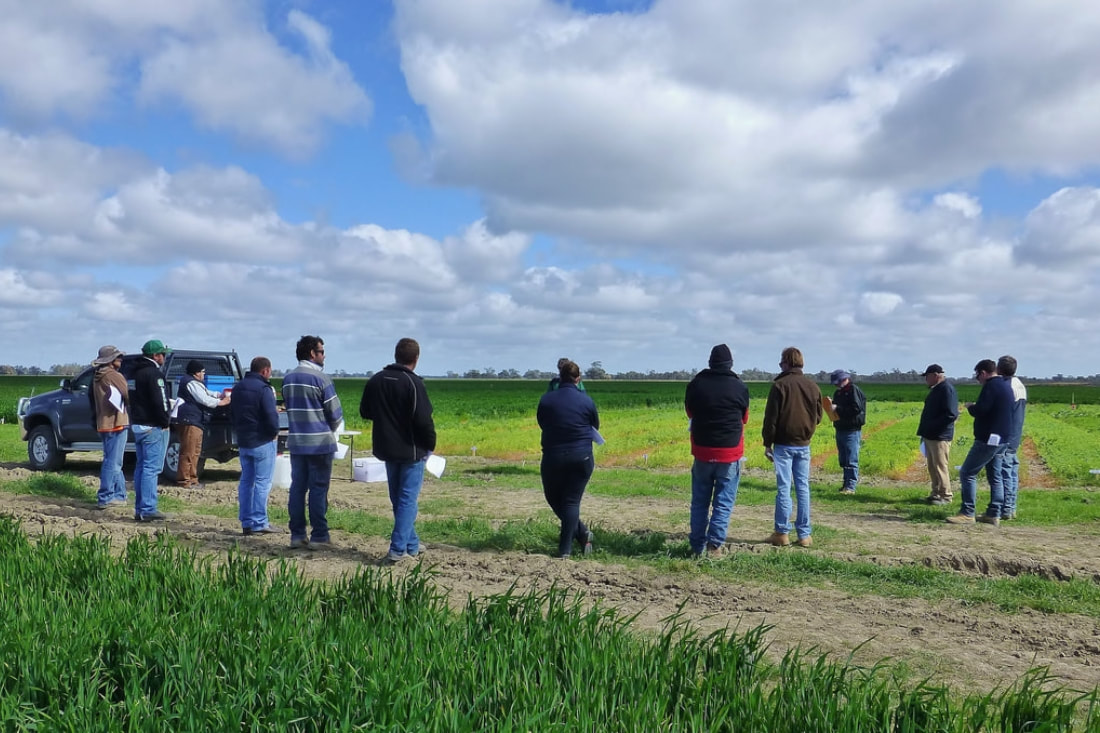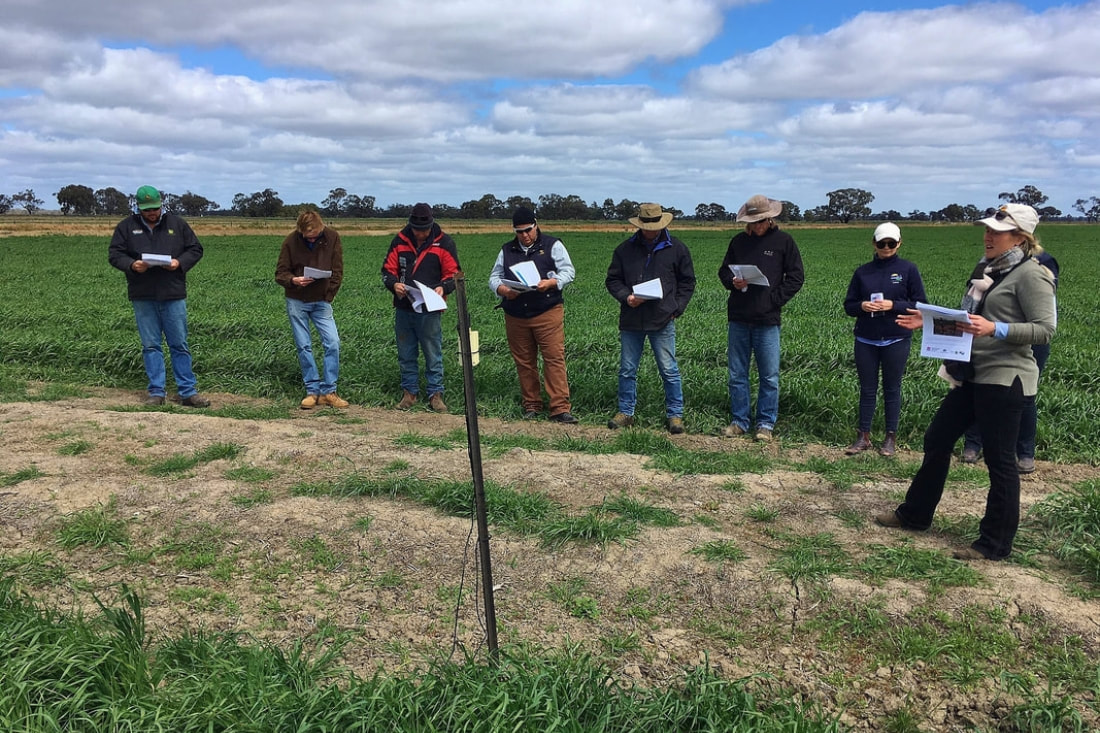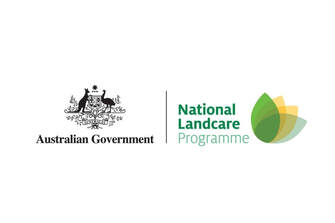Project SummaryThe results from the combined 2016-2017 Western Murray Land Improvement Group and Moulamein Cropping Group trials of lentil, chickpea and Durum Wheat crops planted at two sites at "Tiquito" (Dhuragoon) & "Northdale" (Moulamein) were attended by 21 people on September 19th 2017.
The trial aim for the two legumes was to provide an assessment of waterlogging tolerance in varieties, differing irrigation techniques (overhead irrigation, flood irrigation, beds & subsurface drip), and optimal timings of fungicide application. The focus of the ICC 'Irrigated Durum Trial' was to test different products and fertiliser rates to find the best way to consistently achieve 13% protein in Durum grain. Attendees listened to the findings and participated in a tour of the trial plots. |
Key facts
|
21 Field Day attendees
|
5 local presenters on various trial results and relevant topics
|
Using legume stubble has been found to be beneficials for growing a Durum Wheat crops which requires high protein levels of 13%
|
Challenges exist with Durum trial included ease of supply chain (the closest mill located in South Australia)
|
The impactResults from the trial of the two legumes were successful with this being the first time that it was grown in heavy soils due to large rainfall.
The results from a Durum Wheat Trial were also presented with some key points including the challenge of maintaining protein levels at 13%, the fluctuation of the market with prices ranging from $300-$600/t. An additional challenge at the time of the trial was the proximity of farm to mill (the closest being in South Australia). |
Allena Burger (Moulamein Cropping Group) spoke on the topic of measuring soil moisture:
She outlined:
She outlined:
- Many options to monitor soil content including having something to read in the paddock, to download on to your computer or access remotely
- How to read each graph from the moisture monitors and what the recommended depths of data loggers were 5cm, 15cm and 30cm in a wheat crop to determine where the roots are drawing water
- A comparison of brands of moisture monitoring equipment. Her personal preference was the 'Plexus' system.
Laura Kaylock (MCG/WMLIG) presented on Improving Structure in Sodic Soils.
Alongside a control plot, six treatments were applied which included:
1. Mildly sodic rice bay
2. Compost
3. Manure with stubble
4. Manure without stubble
5. Mulched stubble
6 Gypsum
Findings
Alongside a control plot, six treatments were applied which included:
1. Mildly sodic rice bay
2. Compost
3. Manure with stubble
4. Manure without stubble
5. Mulched stubble
6 Gypsum
Findings
- Gypsum treatment had resulted in the best growing conditions for the plant and hence higher yield.
- There was variation within the trial. The yield map still mirrors the cut and fill map closely, which suggested that treatments have not strongly influenced yield overall
- It could take up to 3-5 years to see any changes from the treatments.
Leigh Vial (Deakin University) presented on the mid-row Banding Nitrogen Trial.
He explained the nitrogen cycle and why it was important to the trial. When Urea is placed in a concentrated band it forms a toxic environment to the soil bacteria which would usually break down fertiliser into a plant available form.
His findings included:
He explained the nitrogen cycle and why it was important to the trial. When Urea is placed in a concentrated band it forms a toxic environment to the soil bacteria which would usually break down fertiliser into a plant available form.
His findings included:
- it takes 10 weeks for the plants to start accessing fertiliser that is applied at the time of sowing.
- bacteria can only break down fertiliser slowly so most of the nitrogen stays in a form which is safe from waterlogging and volatilisation
- previous results suggest that banding nitrogen is just as efficient as topdressing in a "good" season
- banded and early topdressing treatments standing out starkly against the control treatments.
Sam North (NSW DPI) summed up the day with a discussion of yield constraints in the Western Murray and management considerations in irrigation layouts:
- Suggested that yield potential from 7-9t/ha based on the growing season based on sunlight and temperature
- Highlighted the importance of good irrigation layout and scheduling irrigations using soil moisture monitors.
- NSW DPI and partners have been creating guides on how to minimise yield constraints, improve layout and reduce paddock variation.
- When to irrigated high yielding wheat critical drought period as between when awns first appear through to milky dough stage in grains.
- Economic rather than an agronomic considerations inputs should be planned to be appropriate for the yield potential of the paddock.
- Suggested that yield potential from 7-9t/ha based on the growing season based on sunlight and temperature
- Highlighted the importance of good irrigation layout and scheduling irrigations using soil moisture monitors.
- NSW DPI and partners have been creating guides on how to minimise yield constraints, improve layout and reduce paddock variation.
- When to irrigated high yielding wheat critical drought period as between when awns first appear through to milky dough stage in grains.
- Economic rather than an agronomic considerations inputs should be planned to be appropriate for the yield potential of the paddock.
A full list of outcomes can be viewed in the below reports.
Project Partners
This event was supported by the Murray Local Land Services through funding from the Australian Government's National Landcare Program and the Grains Research & Development Corporation.
WMLIG & MCG would like to thank Michael Gorey and Leigh Vial for the use of their properties for the field day, as well as the Barham Bakery and the Wattle Café for their catering.












